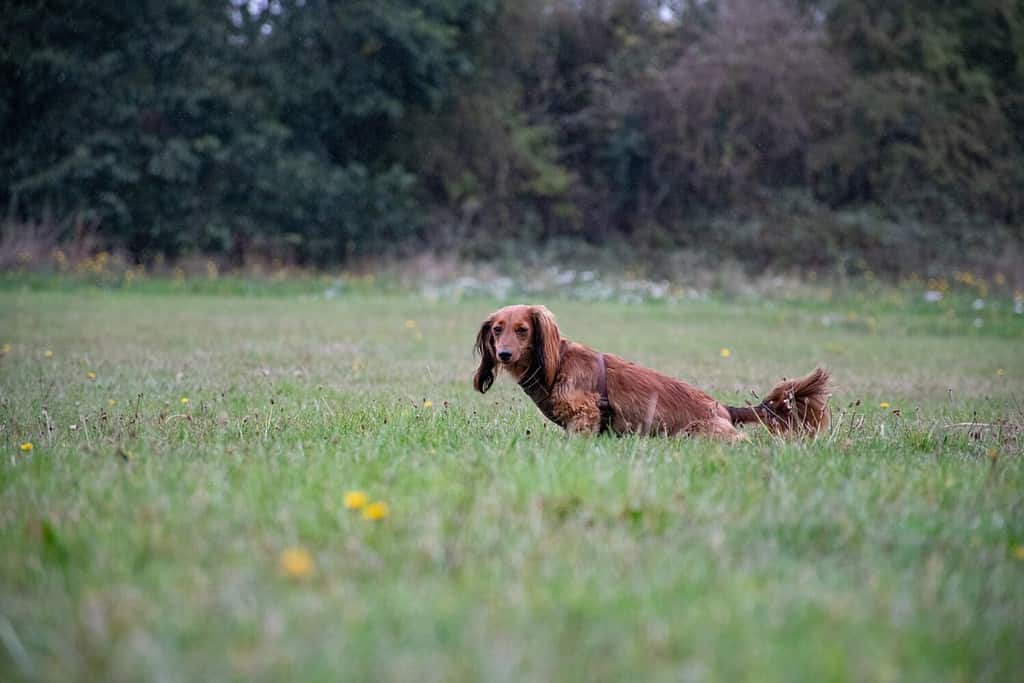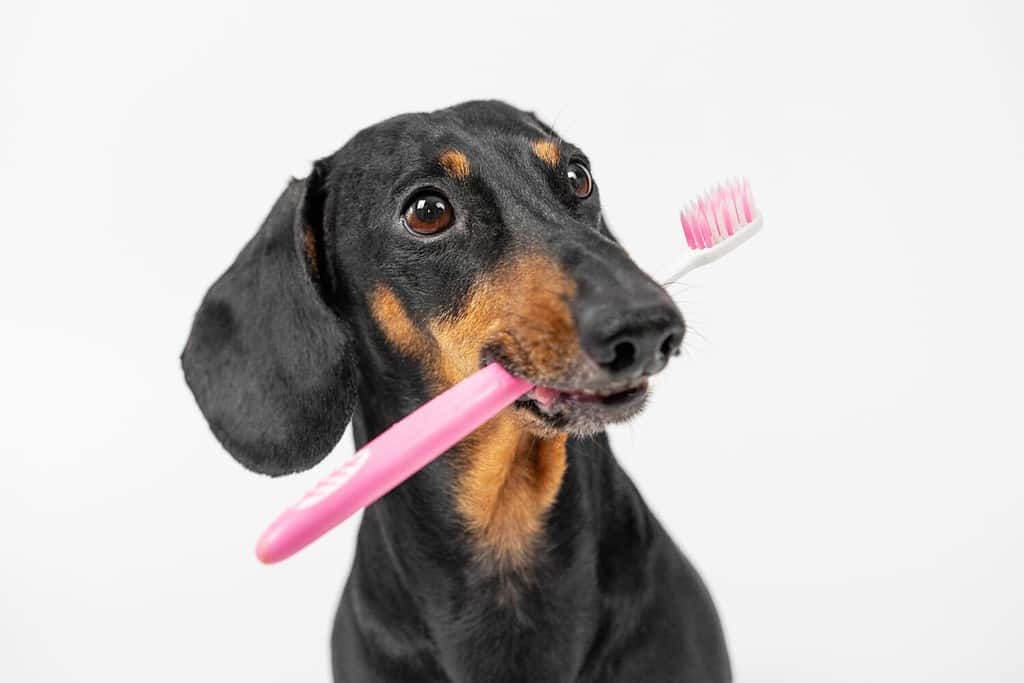You may have heard that dachshunds are stubborn and difficult to train. Is this true, and how do you train a dachshund?
Dachshunds can be stubborn, but they’re also very smart. With the right motivation, such as your dog’s favorite treats, they’ll be eager to please and will learn new cues quickly. We recommend starting with basic cues such as sit and lay down.
In this article, we’ll discuss dachshund training tips, when to start training your puppy, and which cues you should begin with.
Are Dachshunds Easy to Train?

Though you may have some issues training your dachshund, they’re generally very smart and eager to learn.
©Liliya Kulianionak/Shutterstock.com
Dachshunds are smart dogs who learn quickly. However, they’re also known for stubbornness. You can combat this by making training exciting and fun! Bring high-value rewards to the table, such as small scraps of cooked, unseasoned meat.
You might also face common dachshund training challenges such as difficulties with potty training, excessive barking, distraction due to prey drive, and destructive habits linked to separation anxiety.
We’ll talk more about how to solve these problems below.
What Age Should You Start Training a Dachshund?
Dachshunds should start training as soon as you bring them home. Start simple with potty training, socialization, and basic cues, and don’t expect too much from your new pup! It’s important to remember where they’re at developmentally.
For instance, an 8-week-old puppy can’t hold their bladder for more than two hours. You must bring them outside regularly to potty and watch them closely indoors to prevent accidents. Even then, accidents are completely normal at this age!
It’s up to you whether you train your puppy at home, attend training classes, or hire a private trainer to work with you one-on-one. Professional training can be expensive but is also highly beneficial, especially if you don’t have dog training experience yourself.
How do You Discipline a Dachshund?

Focus on preventing future misbehavior rather than on punishment. For instance, keep a lid on your trash can to prevent puppy break-ins!
©Masarik/Shutterstock.com
The best training methods for dachshunds (and for any breed) are positive reinforcement or force-free training. People new to these methods often wonder how to discipline their dogs, however.
The answer is to keep the focus on resolving the issue, not implementing punishments. Here are some great ways to discipline your dachshund humanely and without damaging your relationship with them:
- Start by showing them what you do want through positive reinforcement and redirection. If your puppy is doing something right, like chewing on a toy, give them treats and praise! If they do something wrong, like gnawing on your sweater sleeve, toss a toy to redirect the behavior and praise them for listening.
- Manage the situation to prevent misbehavior. Examples include watching your puppy indoors to prevent potty accidents, or putting food away rather than expecting them to resist temptation.
- “Ignore” misbehavior by removing your puppy or yourself from the situation. If puppy is biting, get up and walk away to show that you won’t tolerate this kind of play. If they potty indoors, simply clean up the mess without reacting–and remember to give them plenty of praise for pottying outdoors!
There’s a lot of common advice out there that is outdated and doesn’t work, or works less effectively than the strategies above.
An example is yelping when your puppy bites. While this does work for some dogs, many dachshund pups will find the noise exciting and won’t realize you’re acting hurt. It may encourage them to bite even more.
Aversive training methods and tools should also be out of the question. We have more effective and more humane training methods available, so it’s vital that we use them!
Socializing Your Dachshund
Socialization is important for your dachshund so that they learn how to behave in new situations. It also tends to lessen anxiety and promote confidence in dogs.
Remember that socialization isn’t only about directly meeting other people or dogs–though that’s certainly a part of it! It also involves being able to walk past them without lunging or barking, behaving outside of the house, and more.
Another key aspect of socialization is learning how to be handled for grooming and health purposes.
Training Your Dachshund Not to Bite
Training a puppy not to bite isn’t difficult, but it does require patience and consistency. It’s best to pick one of the methods below and stick with it:
- Get up and walk away every time your puppy bites and ignore them for a few minutes.
- Keep toys on hand and redirect your puppy to the toy every time they bite clothes or skin.
Remember that this will take time, especially if your puppy is in their teething phase! You may need to limit your puppy’s time around vulnerable people, such as children, while they learn.
How to Potty Train a Dachshund Puppy

Consistency and patience are key to potty training a doxie.
©jack perks/Shutterstock.com
Dachshunds are known for being difficult to potty train, so it may take longer than it has for your other dogs in the past. However, doxies can catch on given time, consistency, and patience.
In the beginning, your puppy should be taken outside at least once every two hours to potty. Stay outside until they go.
Don’t let them roam around the house unsupervised between these outings, or they might find a favorite indoor spot to pee.
Instead, keep them in the same room as you. If needed, keep your puppy leashed so they can’t wander off too far when you’re not looking.
When you can’t watch them, a puppy playpen is the best option in the beginning. You can also work on crate training so that the crate is an option for short periods in the future.
When you are able to watch your puppy, keep an eye out for signs that they need to potty such as circling, sniffing the ground, or squatting. Take them outside immediately if they show these signs.
You’ll also want to go outside first thing in the morning, last thing at night, and directly after playing, eating, or drinking.
Basic Cues for Dachshund Puppies
- Sit, down, and stay are foundational cues that are important on their own, and also to teach other cues in the future.
- Leave it and drop it are essential for a dog’s safety and can prevent choking, poisoning, and intestinal blockages.
- Recall is important for prey-driven dogs like doxies–always keep them on leash outside until they’ve perfected this cue!
- Speak should be taught first, and then quiet so that you have a way to hush your Daschund if they begin to bark excessively.
- Leash manners teach your dachshund not to lunge at people or animals on walks, and to keep the leash loose to make walks more comfortable for you both.
Remember to focus on only a couple of cues at a time to avoid overwhelming your puppy. Move on to new cues once they can listen to the initial cues reliably.
Advanced Training for Dachshunds

Doxies can learn to find hidden items, perform fun cues like bowing, and more!
©Masarik/Shutterstock.com
Dachshunds can be limited by their size and delicate backs–for instance, jumping isn’t the best for them. Aside from this, however, there are plenty of things your dog can learn.
Advanced training doesn’t have to be anything fancy, either. You could spend ten minutes a day practicing old cues and adding in new ones over time. Or, you could attend advanced training classes once you’ve passed your puppy class together.
Some people prefer to focus on useful cues like finding lost items, while others love fun, cute cues like playing dead.
Overall, it’s up to you how much training you put into your dachshund pup. So long as they know the basics and get enough mental stimulation in their day, that’s all that truly matters!
The photo featured at the top of this post is © koumaru/iStock via Getty Images
Ready to discover the top 10 cutest dog breeds in the entire world?
How about the fastest dogs, the largest dogs and those that are -- quite frankly -- just the kindest dogs on the planet? Each day, AZ Animals sends out lists just like this to our thousands of email subscribers. And the best part? It's FREE. Join today by entering your email below.
Thank you for reading! Have some feedback for us? Contact the AZ Animals editorial team.







